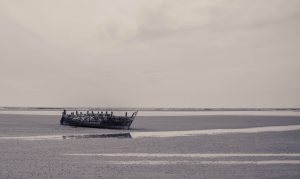A maritime dispute between India and Sri Lanka remains unsolved, despite an agreement 47 years ago. Notwithstanding the 1974 Indo-Lanka Maritime Boundary Agreement, Indian fishermen tend to cross the maritime border into Sri Lanka in the Palk Strait, which in turn leads to assaults by the Sri Lankan Navy. The latest incident, which led to the death of four Indian fishermen, has once again brought the dispute to the fore.
On January 18, four Indian fishermen went missing as they ventured into Palk Strait. A few days later, the Sri Lankan Navy announced that it had recovered four bodies, suspected to be of the missing fishermen. As news reached the shores of the Indian state of Tamil Nadu, protests erupted as more than 200 fishermen blocked roads. They demanded 1.5 million Indian rupees (about $20,620) in compensation for the affected families and the filing of murder charges against the Sri Lankan Navy. However, the latter rejected the allegations and issued an official statement, blaming the fishermen instead.
In an interview with The Hindu, the Tamil Nadu representative of the Alliance for the Release of Innocent Fishermen, U. Arulanandam, alleged that the fishermen were beaten to death by Sri Lankan naval officers. “The pictures of the bodies bear many injuries and deep cuts. Blood clots and stains could be seen. There wouldn’t be blood clots if they had drowned,” he said. He further stated that even if the fishermen had crossed the maritime boundary, they should have been arrested and not killed.
Reacting to the death, India lodged a “strong” demarche with the Sri Lankan high commissioner in New Delhi and with the Sri Lankan Foreign Ministry via the Indian High Commission in Colombo. While announcing compensation of one million Indian rupees (about $13,746) and a job for each victim’s next of kin, the Tamil Nadu Chief Minister Edappadi K. Palaniswami urged Indian Prime Minister Narendra Modi to inquire about the incident through the Indian High Commission in Sri Lanka.
The latest incident is an addition in a long list of cases of harassment of Indian fishermen by the Sri Lankan Navy.
Why do Indian fishermen cross the maritime border despite the obvious risks? For centuries, Indian and Sri Lankan fishermen communities have been fishing in each other’s waters without conflict. The scenario changed when India and Sri Lanka signed four Maritime Boundary Agreements between 1974-76, which defined their respective understanding of the international maritime boundary between the two countries. The idea behind these agreements were that they’d facilitate law enforcement and resource management in the Palk Strait. Through the agreements, the Katchatheevu Island was ceded to Sri Lanka by the Indian government without consulting the Tamil Nadu state government. Since then, Indian fishermen have only been allowed “access” to the island for resting, drying of nets and the annual St. Anthony’s festival, but not for fishing.
Despite the agreements, there is no well-defined maritime boundary between the two countries, leading to Indian fishermen trespassing into Sri Lankan waters in search of a better catch. Between 1983 and 2009, Indian fishermen had easier access to the rich Sri Lankan waters as the maritime boundary in the Palk Strait was not heavily guarded.
Since 2009, the Sri Lankan navy has tightened surveillance of its northern maritime boundary to halt a potential return of Tamil insurgents. This, in turn, has had the secondary effect of increasing the number of arrests of Indian fishermen, even as Sri Lankan authorities argue that they are simply protecting the maritime boundaries of the country against poaching, and securing the livelihood of Sri Lankan fishermen.
Is the dispute solvable? Following the latest incident, the Sri Lankan Fisheries and Aquatic Resource Minister appointed a three-member committee to find a lasting solution to the issue. According to the minister, India had accepted a draft solution submitted by Sri Lanka in January last year, but further progress was halted due to the COVID-19 pandemic. Indian and Sri Lankan representatives met again in December as part of the Joint Working Group on fisheries, where Sri Lanka had suggested joint patrols and operations between the two countries to guarantee effective results on illegal fishing and trespassing. Despite having met more than once since 2016, a solution is yet to be finalized.
Irrespective of the circumstances, a potential solution to the dispute relies on the response from the respective governments of India and Sri Lanka. If both countries are unable to settle the dispute, then they could seek assistance from international maritime experts through the United Nations.
Jeevethan Selvachandran holds an MA in India and South Asia Studies from Aarhus University, Denmark.

































